|
- Team Durango DEX210V2 - Review -
1/10-SCALE ELECTRIC 2WD BUGGY - KIT
Revamping the Swiss Army knife of the 2WD buggy class
By Aaron Waldron - Photos: Joel Navarro
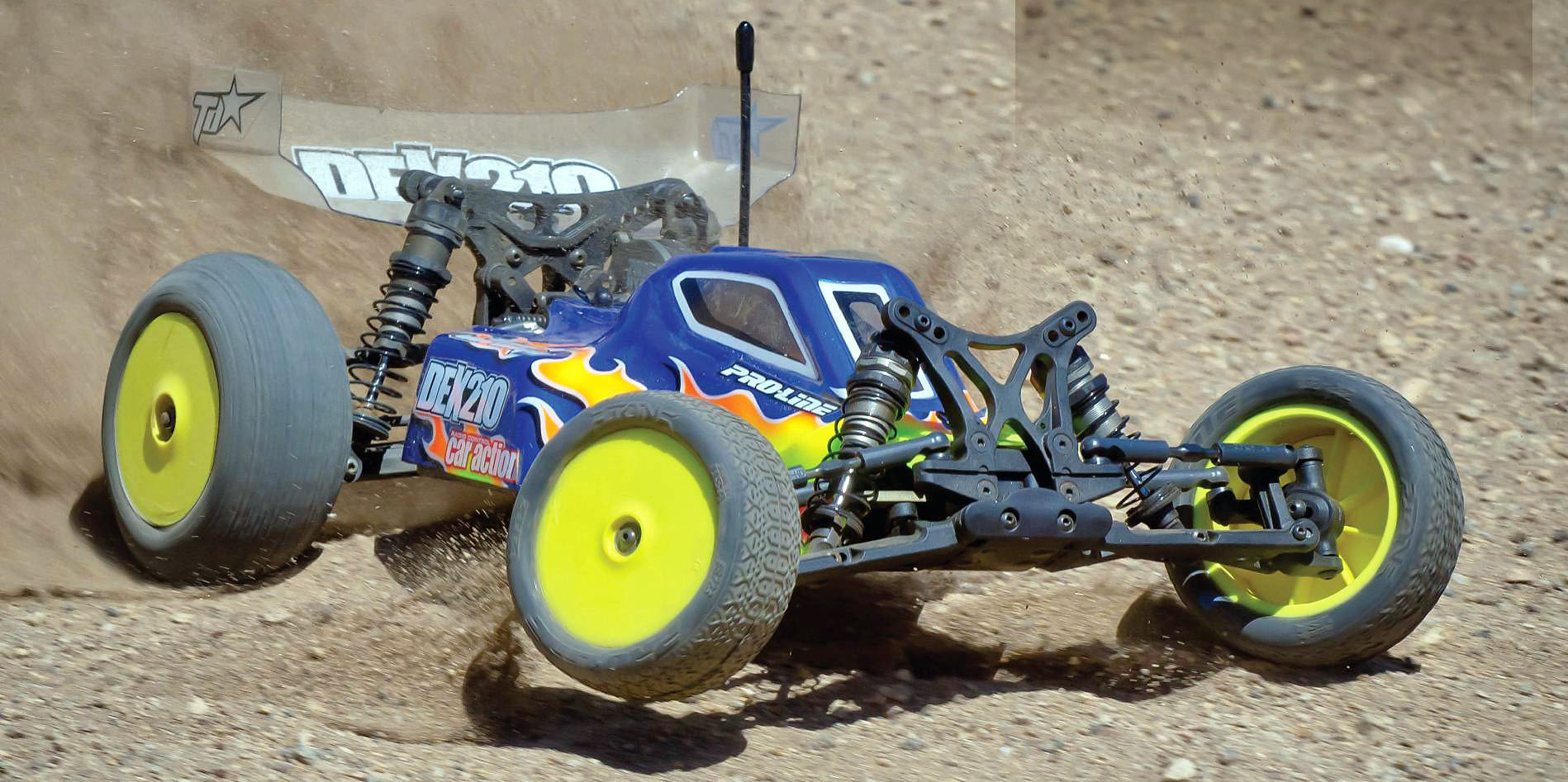
When Team Durango released the original DEX210 three years ago, they were a major standout in the surge of new manufacturers jumping into a 2WD buggy arena that had been a two-horse race for the better part of three decades. Born from the mind of German hardcore racer-turned-engineer Gerd Strenge and bred in high-level racing across Europe, Durango brought new design ideas and never-before-seen adjustability to the class. The fresh approach to a 2WD buggy was unique, because it had to be. The car was destined for the carpet and Astroturf courses of Europe as well as the high-speed dirt tracks of America. As a result of this forward thinking, the DEX210 was easily the most successful of the division’s newcomers, netting national championships across the Old World and the highly coveted Invitational title at the Reedy International Race of Champions. Much like Durango has done more than three revisions to their 4WD buggy, Strenge and his team drivers never stopped working on ways to improve the platform, stopping only long enough to win last year’s 2WD European Championship. The result of this development is the DEX210v2, with a long list of changes to make it faster, stronger, and easier to drive.
EXTRA-ADJUSTABLE AERO-ARM SUSPENSION
The biggest changes to the v2 buggy are attached at both ends of the chassis. Durango kept its innovative steering knuckle design that uses replaceable inserts to adjust axle trail, but they’re affixed to the end of radically different front arms that forego drastic gullwing upsweep of the original DEX210. Along with the inevitable geometry change, which should lead to smoother and less aggressive steering, as the arms increase the ground clearance of the arms over rough terrain. Further, the “aero-neutral” arms are shaped to minimize the drastic upward angle caused by the kickup of the front bulkhead in order to reduce aerodynamic lift, though it will be difficult to quantify just how much difference that actually makes. What will make a huge difference, however, is the extra webbing and material used to make the arm, which should make them much more durable than the arms they replaced. The front shock tower is tougher as well as it’s made of a stiffer material than the original car, and now features a rearward-swept profile that makes it easier to access the inboard front ballstuds.
The rear shock tower is revised as well, and is shorter than the previous DEX210’s, giving the v2 more downtravel for plusher jump landings. The material is stiffer, and with redesigned webbing there’s more of it, for increased strength in high-speed crashes. The rear arms now boast shock mounting holes on both the front and rear, allowing the rear shocks to be mounted in front of or behind the tower. Durango says that mounting the shocks in front of the tower will offer smoother transitions across surface changes and increased cornering agility, while bolting the dampers to the back of the tower increases forward traction on low-grip surfaces for higher straight-line stability. A low roll-center rear pivot block is standard on the v2, which generates more forward grip, and the transmission case has been redesigned to offer a second inboard camber link mounting option with more material added around the mount for more durability. Durango’s 12mm “Fat Shock” big bore dampers with 3mm plated shafts are carried over from first-gen DEX.
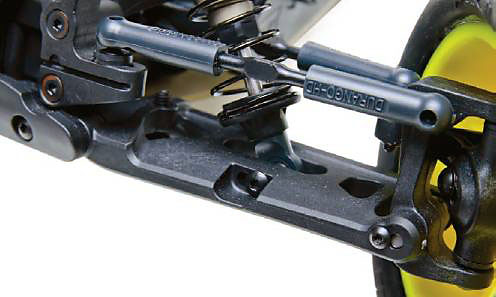
Straight front arms increase ground clearance over the previous gullwing design, but they mellow out the steering response too. Will aerodynamically shaped front arms become a thing? We’ll see.
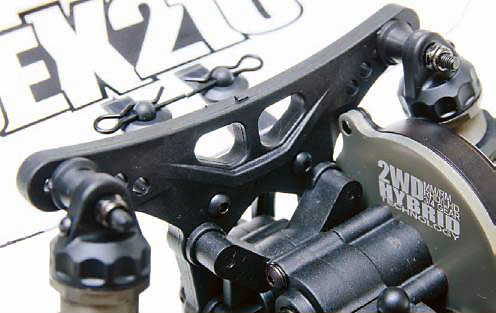
The shock positions of the shorter rear tower are the biggest change to the rear suspension. Durango’s 12mm “Fat Shock” big bore dampers are unchanged from the v1 kit.
MACHINED & HARD-ANODIZED CHASSIS
The hard-anodized aluminum chassis that forms the backbone of the DEX210v2 is 8mm longer than the original, with the primary benefit of greater stability on rough, high-speed tracks and when landing from jumps. The narrow plate features a machined slot designed to accept optional chassis weights for further tuning of weight distribution, is bolstered with plastic bolt-on side plates that are larger than the v1 for a better fit with the new cab-forward body as well as offering more mounting room for electronics. The battery channel is long enough to accept shorty, standard, and saddle packs when placed in line with each other, even in mid-motor configuration, with a small amount of room to move the pack back and forth. Up front, you’ll find a new aluminum steering rack that replaces the plastic piece from the original buggy for more precise steering response and less deflection on rough surfaces. The rear of the chassis is bolstered with a new “finger brace” design that detaches with the removal of just six screws, making it easier to access the gearbox and pivot block in rear-motor configuration, or the motor when the chassis is assembled with the motor mounted amidships.
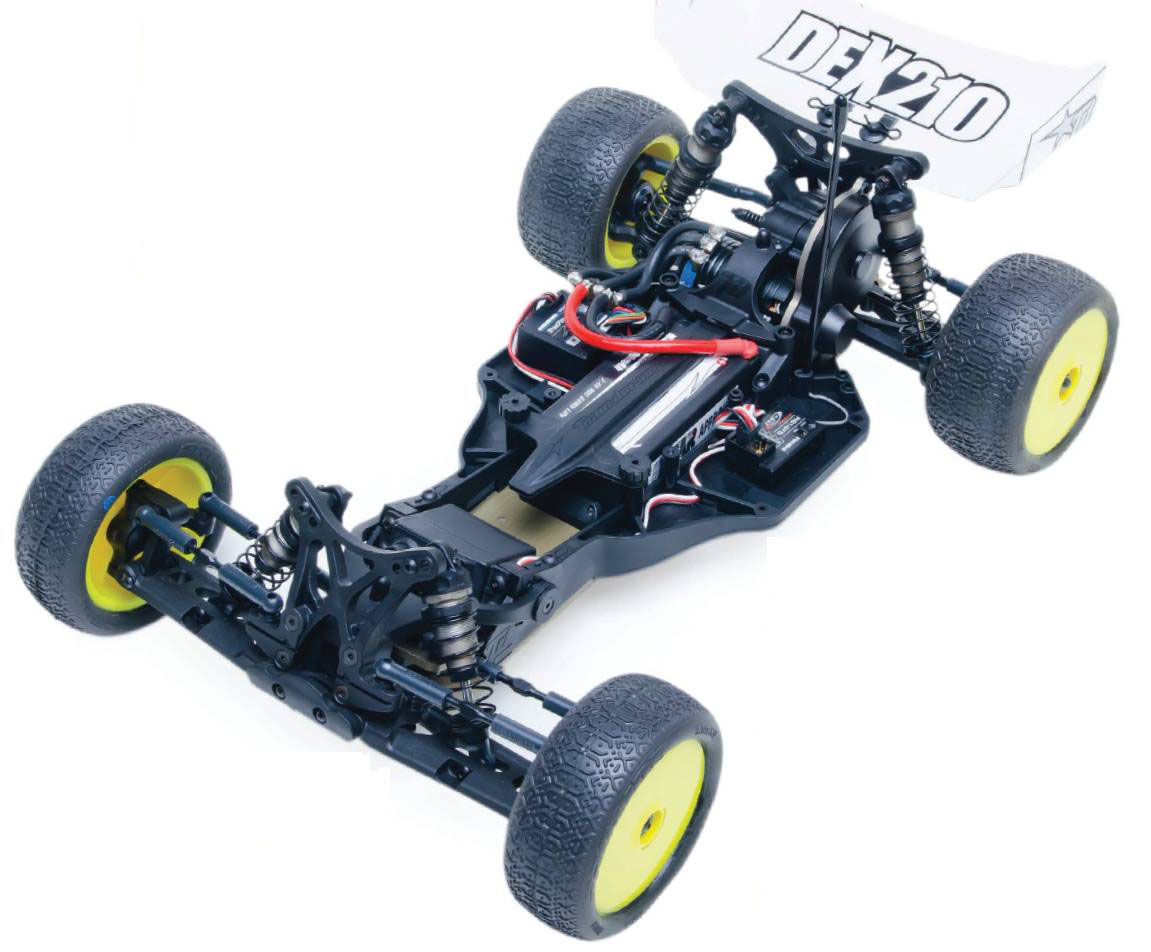
It may be difficult to spot most of the updates to the v2 buggy over the original, but each little tweak and change makes a big difference on the track.
MULTI-POSITION TRANSMISSION
One of the most notable features of the original DEX210 was its innovative transmission design that could be built with three or four gears, in order to reverse the motor’s left-to-right orientation, and installed in front of or behind the rear shock tower, all without extra parts. Nearly all racers chose either a standard 3-gear rear-motor build, or a typical 4-gear mid-motor configuration, but it’s still an interesting option that will give tinkerers and non-stop tuners plenty of replay value as they continue changing their cars every other race night. Though Durango offers an optional gear differential, the v2 employs the smooth ball diff from the original buggy, fitted with new outdrives that are longer to prevent the driveshaft from popping free – especially important given the car’s added downtravel from the shorter rear shock tower. Also, to cope with the increased travel, the CV-joint of the rear axle has been redesigned for greater articulation, up to 39 degrees.
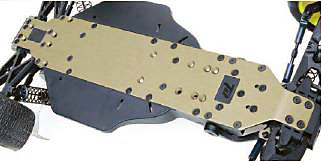
The DEX210v2 chassis is 8mm longer ahead of the battery compartment, shifting the buggy’s weight bias slightly rearward.
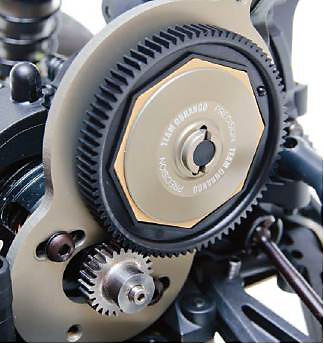
Unlike other cars in its class, the slipper adjustment nut and spring are located on the opposite side of the transmission from the spur gear and pads.
VEHICLE SPECS
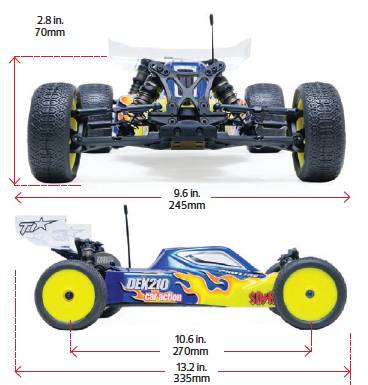 Item no.: TD102028
Item no.: TD102028
Scale: 1/10
Price*: $280
Weight, as tested: 3 lb., 9.6 oz. (1650g)
CHASSIS
Material: Machined aluminum, hard anodized
Type: Plate
SUSPENSION
Type: Lower H-arm with upper camber link
Inboard camber link positions (F/R): 2/2
Outboard camber-link positions (F/R): 2/4
Shock positions, towers (F/R): 3/5
Shock positions, arms (F/R): 2/3
SHOCKS
Bodies: Threaded aluminum, 12mm bore
Shafts: 3mm steel plated
Volume compensation: Emulsion
DRIVETRAIN
Type/ratio: Three-gear transmission/2.6:1
Spur gear/pinion: 81/not included
Slipper clutch: Adjustable dual-disk slipper
Differential: Adjustable ball differential
Driveshafts: Steel CV-style driveshafts
Bearings: Rubber-sealed
BODY, WHEELS & TIRES
Wheels: Team Durango dish wheels, yellow
Tires: Not included
Body: Clear Lexan, untrimmed.
TEST GEAR (NOT INCLUDED)
Transmitter: Futaba 4PKS-R
Receiver: Futaba R614FS
Speed control: Trakpower MS-1
Motor: Trakpower 8.5-turn
Steering servo: Futaba BLS272SV
Battery: Trakpower 2S 4500mAh 90C Shorty LiPo
Tires (F/R): Pro-Line ION Front 2WD tires, MC compound/ Pro-Line ION 2.2” Rear tires, MC compound
TEST GEAR TRAKPOWER MS-1
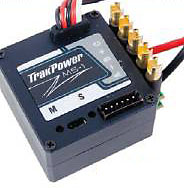
The MS-1’s most prominent feature is definitely the aluminum case, which weighs a bit more than you might think for a unit of this size, but it’s packed with tuning options and a seamless driving experience that allows the racer to focus on cutting clean laps.
With its black machined aluminum case, the Trakpower’s racing-level speed control scores a “10” in bling factor, though it receives high marks in other regards as well. The MS-1’s tiny footprint and location of the receiver lead, sensor harness, and five gold-plated solder posts make it easy to install in almost any kit, let alone the larger side guards of the DEX210v2. Saying at this ESC has a “motor limit” of 2.5 turns is a bit silly, since not even on-road racers use anything lower than that, but it’s nice to know that the unit is more than up to the task of anything you’ll likely bolt into place, especially the 8.5-turn motor I used as well as the 6.5, 10.5, 13.5, and 17.5 motors with which it’s also available. Myriad useful tuning options, like drag brake and “start power” are easily accessed via pressing buttons and counting LEDs, and Trakpower’s “MS Connect” works much better than its Microsoft-sounding name would lead you to believe.
BEHIND THE WHEEL
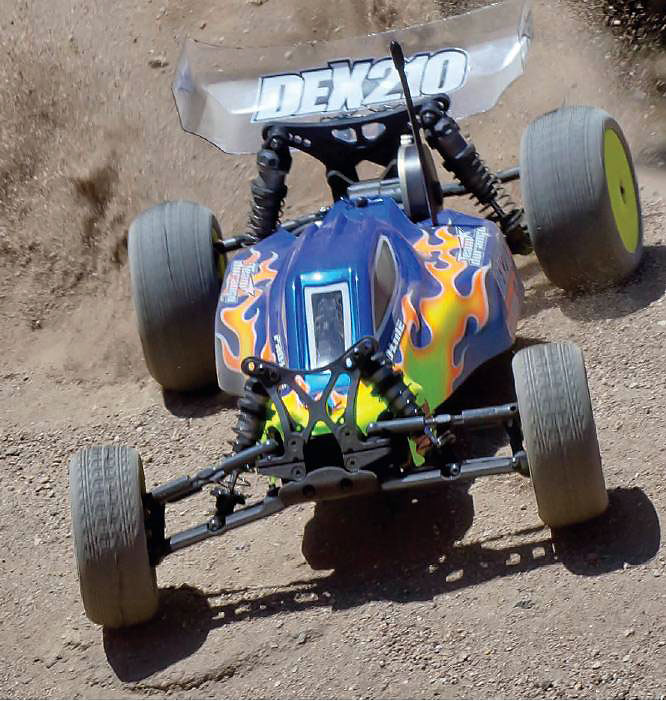
I certainly didn’t need another excuse to head to my local indoor track, SDRC Raceway, but completing the DEX210v2 kit build was enough motivation to pack my truck and hit the road. During my final assembly of the car, I didn’t even bother trying to install the useless front body clip tucked under the front shock tower and instead used strips of Velcro along the chassis guards to hold the body in place. I’m also thankful that I double-checked the alignment of the wing mounts before reaming the pre-marked hole locations, as they’re not correct for when the car is built in mid-motor. Although I had several pairs of tires for other cars ready to be bolted in place, I learned that I still couldn’t use them on the v2 thanks to Durango’s insistence on non-standard 14mm hexes – needless to say, test day got off to a bit of an aggravating start. I glued up a set of Pro-Line’s MC-compound Ions, which have quickly become one of my favorite tires on warm days, spun up the differential on the pit table for a few minutes in order to seat the parts for proper setting of the diff and slipper, and took it easy for the first pack on the track while the tires broke in. Confident that the car was ready to go, I installed a fresh battery and got down to business – and it’s a good thing I had the foresight to set the MS-1’s “Initial Throttle” setting to “Lowest,” because the 8.5-turn motor needed no help yanking the front tires free from their contact with the clay. The added stability afforded by the v2’s extensive suspension and chassis updates is apparent from the first pull of the trigger, as the car squares up and takes off with nary a squirm. With more grip, it’s easier to pick up the throttle sooner exiting corners or dive to the inside of turn one from a standing start. With the longer chassis in place, the v2 holds its line when traversing rougher sections of the track and is likely the most important part of the recipe when it comes to the buggy’s overall stability as the car soaks up rough jump landings with ease. I found that the car jumped more controllably and landed with a softer touch than previous edition DEX210’s that I’ve driven, transforming jump combos from “a section to survive” into passing opportunities. Durango’s 12mm big-bore shocks, among the first to be used in the 2WD class on the original DEX, do an excellent job of taming chop and the kit setup worked well even for the high-bite clay surface. Along with the chassis, the additional rear down-travel that’s easily adjustable thanks to the droop screws, no doubt plays a part in the car’s rough track prowess and phenomenal rear grip.
The kit setup for the v2 calls for trailing axles, which tame the car’s initial turn-in aggression for smooth corner entry, especially at speed. The progressive feel of the steering response made it easy to carve clean lines around the infield of the course and I rarely felt like the buggy was at a loss for steering response while simply lapping on a practice day, though I may have tried different inserts on a race day in order to find that extra edge for turning inside a competitor in order to make a pass. Rather than spend time changing the inserts, however, I bumped up the drag brake setting on the MS-1 from 10% to 20%, and that helped enough to quell my desire for more steering. I found the v2 to be more stable under braking than its predecessor, requiring less patience when getting on the binders to set up for a slow corner and giving me the confidence to pitch the car into the apex sideways before dropping the hammer to hit the next jump.
FINAL WORD
Team Durango’s DEX210 was a refreshing addition to 2WD buggy racing because it broke the mold of what a competitive car had to look like, and for that reason alone it still stands out among its competitors. In typical Team Durango fashion, the updates they’ve included with the v2 make such a profound effect on how easy it is to drive, work on, and live with the car that you can’t help but wonder why that wasn’t how it was done in the first place, but that’s how competitive racing works – you don’t know until you try. From the updates to the suspension, to the longer chassis, to the redesigned outdrives and driveshafts, and even the new ball cups and ball studs – the DEX210v2 is an upgrade over the original.
+ Revisions radically transform overall driving performance
+ Key updates make the car easier to disassemble for maintenance
+ Incredible amount of tuning options
- Still uses non-standard 14mm hex wheels
- Front body clip is still frustratingly impossible to access
- Marks for wing mount holes are for rear-motor only
SOURCES
Team Durango team-durango.com
Fatty Grafx fattygrafx.com
Futaba futaba-rc.com
Pro-Line Racing prolineracing.com
Trakpower Speed Equipment trakpowerusa.com
Source:

|
